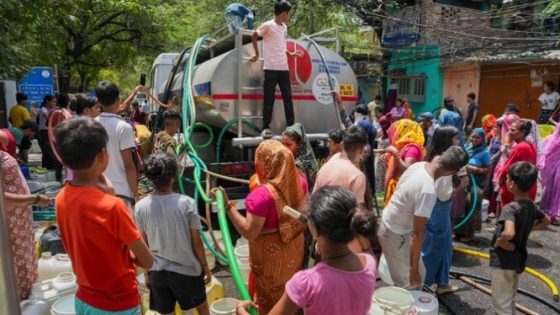An exclusive investigation by India Today has revealed troubling conditions in Bawana, where unregulated industrial water consumption, driven by a pervasive water mafia, is worsening Delhi’s water crisis.
BAWANA: FROM MODEL INDUSTRIAL ESTATE TO REGULATORY NIGHTMARE
Developed in 1999 by the Government of NCT of Delhi and managed by the Delhi State Industrial and Infrastructure Development Corporation, Bawana was intended to be a model industrial estate. It was designed to provide a planned setup with all necessary infrastructure for relocating non-conforming industries. However, 25 years later, Bawana has become infamous for its unauthorised factories that flagrantly violate regulations.
UNCHECKED WATER RESOURCE EXPLOITATION
The India Today expose highlights serious issues with water resource management and corruption in the Bawana industrial area, directly contributing to the depletion of Delhi’s groundwater. While industries enjoy an unrestricted water supply, residents of Bawana face severe water shortages, especially during the hot summer months.
ILLEGAL BOREWELLS AROUND WATER CANALS
Illegal borewell operations are rampant near the Munak canal’s Delhi Sub branch, which transports water from Haryana to Delhi. Although borewells are banned across Delhi, Bawana hosts over 16,000 plots, with only 1,000 to 1,200 units having pre-sanctioned borewells leased from the Municipal Corporation of Delhi (MCD) for 99 years.
Sources within Bawana Infra suggest that most units avoid metered water connections, relying instead on tanker mafias.
INSIDE THE TANKER MAFIA OPERATIONS
In a sting operation, India Today’s Special Investigation Team (SIT) posed as factory owners to infiltrate the tanker mafia. During the sting, Sanjay Dahia, a member of the tanker mafia, revealed the extent of their operations.
Dahia said, “We can supply water daily, though sometimes there might be a delay of an hour or two. The rate for 5,000 litres is Rs 1,200 in Sector 5, Block B, and Rs 800 in Sector 2. We take water from the canal. There’s no worry about police interference because we pay them monthly bribes.”
EXTENSIVE BRIBES AND CORRUPTION
The sting operation revealed that tanker mafias are able to operate smoothly due to regular bribes.
Leela Sehrawat, another mafia member, confirmed this, stating, “You just need to arrange the tanker. The costs for police and SDM bribes are our concern, not yours.”
ECONOMIC AND ENVIRONMENTAL IMPLICATIONS
The high demand for water with low Total Dissolved Solids (TDS) is driven by the fact that most borewells within industrial units produce high TDS water, which damages machinery.
This has created a supply chain where mafias operate borewells near the Munak canal to obtain good quality water. As a result, property rates around these water canals have surged due to rampant and unchecked water extraction.
OPERATIONS OF TANKER MAFIA RAISED IN INTERNAL MEETING
During a recent meeting, senior officials confirmed that issues of water theft along the Munak canal’s Delhi Sub Branch had been raised.
Separately, amid the ongoing water dispute between the Delhi government and Haryana, a meeting was held at the LG’s office to review an inspection report by the Central Water Commission (CWC) and the Upper Yamuna River Board (UYRB) along the Munak canal and Delhi Sub Branch leading to Delhi.
DETAILS OF THE INSPECTION REPORT
– Haryana released 2,289 cusecs of water at Munak on Sunday.
– Of this, 1,161 cusecs were designated for exclusive supply to Delhi, against a quota of 1,050 cusecs.
The amount of water received from the Munak canal at Bawana in Delhi was 960 cusecs.
– This indicates a loss of 200 cusecs, or 18 percent, along the Munak canal via DSB & CLC leading to Delhi.
– Accepted norms state these losses should be less than 5 percent.
A senior official from the Upper Yamuna River Board explained that a faulty meter was the reason for the low water reading in Delhi. During an inspection, an acoustic doppler current profiler (ADCP) suggested that the flow of water was more than the indicated 960 cusecs. The official also mentioned that while borewell operations along the canal deplete water resources, they do not affect real-time water flow measurements. Additionally, leaks along the Munak canal contribute to water loss. The Delhi government maintains that Haryana is not releasing its share of 1,050 cusecs through the Munak canal via DSB & CLC.
NEED FOR URGENT REGULATORY ACTION
Sources from Bawana Infra point to a lack of cooperation from the Municipal Corporation of Delhi and the Delhi Jal Board, exacerbating the situation. The investigation highlights the urgent need for regulatory action and transparency to protect Delhi’s water resources and curb corruption.
The future of Delhi’s water supply is at stake, and immediate action is necessary to address this crisis. Authorities must implement stringent measures to control illegal water extraction and hold those responsible for corruption accountable. This exposé calls for an immediate and robust response from regulatory bodies to secure Delhi’s future water.
Source Agencies



